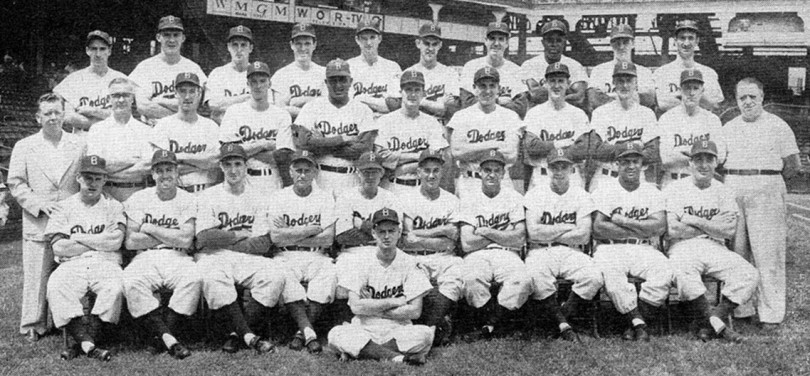
Reference Biography: Walter O’Malley
The Memorable First Season
In 1951, O’Malley’s first season at the helm of the team ended as one for the history books. The Dodgers and archrival Giants were forced to play a three-game playoff series to determine the National League Pennant-winner. The Dodgers had led the Giants in the standings by 13 1/2 games in August until they hit a late-season slump and the Giants reeled off 16 straight wins. Tied at a game apiece in the playoffs, the Giants hosted the Dodgers at the old Polo Grounds on October 3, 1951 in what would become one of baseball’s most memorable moments, and one of the most painful for Dodger fans.
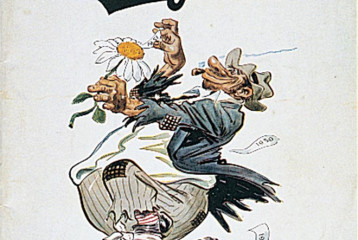
1951 Dodgers Yearbook
Copyright © Los Angeles Dodgers, Inc.
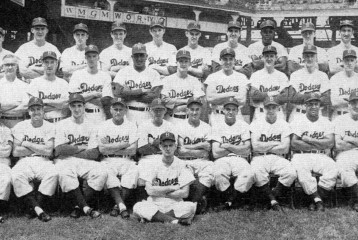
The 1951 Dodgers shown here lost a heartbreaking playoff to the New York Giants on Bobby Thomson’s ninth-inning home run at the Polo Grounds on Oct. 3.
Copyright © Los Angeles Dodgers, Inc.
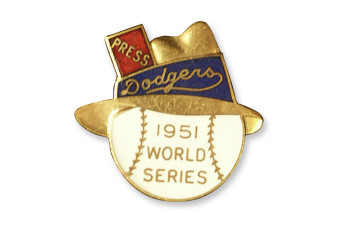
1951 Phantom - Dodgers press pin
With the Dodgers leading 4-1 in the bottom of the ninth inning, the Giants got a single by Alvin Dark and another base hit by Don Mueller. Monte Irvin popped out, but Whitey Lockman doubled in a run and made it 4-2 against a tiring Newcombe, who had pitched frequently in the last week and was lifted by Dodger Manager Charlie Dressen for Ralph Branca, as Bobby Thomson was coming to the plate. Erskine, also getting ready in the Dodger bullpen had bounced an overhand curve and Coach Clyde Sukeforth told Dressen on the bullpen phone that Erskine had bounced a pitch and that Branca looked sharp. On that basis, Dressen summoned Branca in to pitch. In a playoff game two days earlier, Branca had yielded a home run to Thomson. Once again, Thomson connected and electrified the crowd when he hit a dramatic three-run home run into the left field stands off the beleaguered Branca. The Giants prevailed, 5-4, crushing the hopes of Dodger fans, as Russ Hodges said repeatedly on the radio, “The Giants win the Pennant. The Giants win the Pennant...!”
The agony of that shocking defeat lingered for some time according to O’Malley.
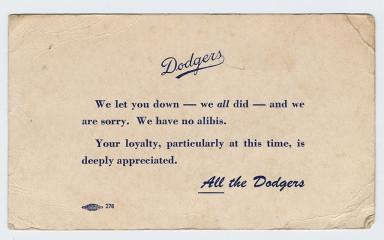
The Dodgers issued an apology to their fans following their playoff loss to the New York Giants in 1951.
“No, I didn’t get over it too quickly,” he said. “That bothered me practically all that year.”
Still thinking about that, O’Malley was honored on January 17, 1952 by the Cathedral Club in Brooklyn at the Grand Ballroom of the Hotel St. George as “Brooklyn’s Catholic Man of the Year”.
Had fate taken a different turn, John F. Kennedy would have been president, all right, but not of the United States. In 1950, Joseph Kennedy was looking for something different for his son to do and he made several inquiries to O’Malley. The elder Kennedy wanted to buy controlling stock interest in Brooklyn and then hand the reins to his intelligent son.
“It seemed that Joe Kennedy was worried about Jack’s war injury,” said O’Malley. “Jack was then a freshman congressman, and his back was giving him a lot of trouble. Joe Kennedy said he had high hopes for Jack in politics, but he had begun to wonder if the boy was up to it physically. He said Jack was fond of baseball and, if politics was out, he might like to run a ballclub. Joe Kennedy said he was ready to meet anybody’s price for a controlling interest, with the idea of putting Jack in as club president.
“Then, while things were still in the early talking stage, North Korea invaded South Korea. (President) Truman sent troops, the Chinese came in, there were wild rumors out of Moscow, and Joe Kennedy decided that World War Three was upon us. He called off everything and predicted that soon there wouldn’t be baseball at all.”
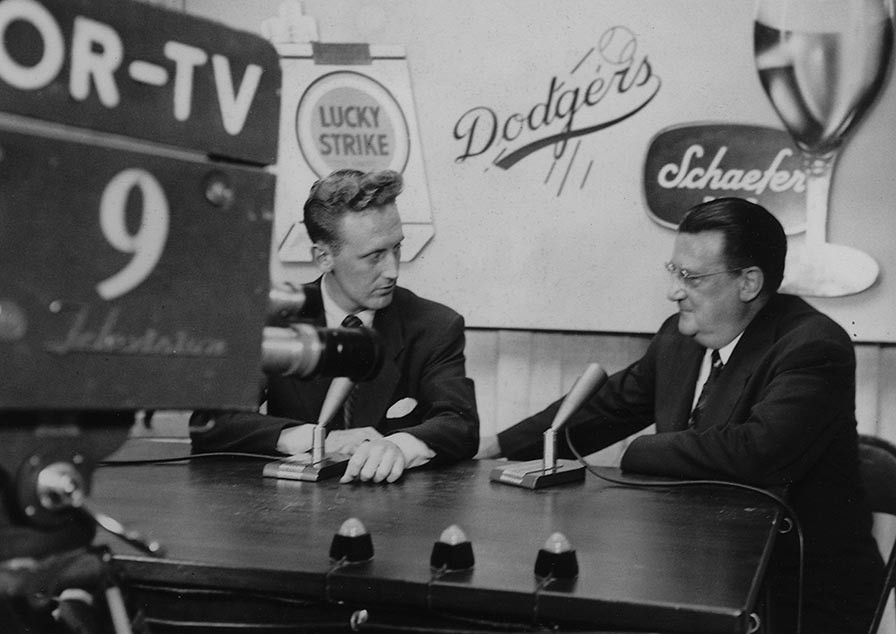
Walter O’Malley appears on television with Dodger broadcaster Vin Scully.
Following the 1951 heartbreak at the Polo Grounds, O’Malley decided to turn his fortunes around by wearing a good luck cat’s eye ring, which was once owned by financier Diamond Jim Brady. It was “given to him by a friend who insists if the Flatbush boss had worn it last year, it would have prevented the ‘Miracle of the Giants.’” The Sporting News, September 3, 1952 A little luck of the Irish, or cat’s eye in this case, certainly couldn’t hurt and it didn’t.
As a major proponent of the idea of subscription television, O’Malley investigated the possibility of Pay TV for the Dodgers in Brooklyn as far back as 1951-52. He realized that a subscription TV service would add to the coffers of the ballclub, build additional interest in the Dodgers and reach many more fans than were attending games in person at Ebbets Field. “As far back as ’51-’52, when TV revenue was less than half it is today, O’Malley was talking about selling the games at 50 cents a shot. He even suggested that, given the go-ahead signal, a group financing him would wire some representative city, assuming the entire cost. At that time, he figured installation costs, per set, would run about $125.” Harold Rosenthal, Sports, New York Telegraph, April 29, 1962
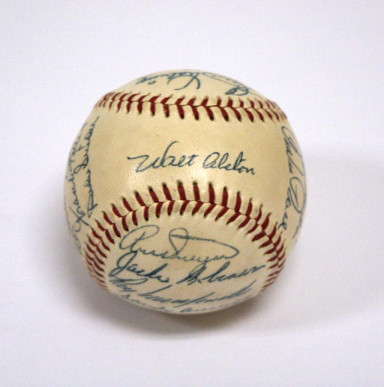
Walter O’Malley’s idea of bringing fans closer to the players results in the first Autograph Day at Ebbets Field in June 1952.
O’Malley believed “that the time has passed when an operation like big league baseball can depend upon the revenue from gate receipts alone.” He said, “Even if we didn’t telecast, there isn’t a night in the week that our attendance won’t be affected by something like Milton Berle or ‘I Love Lucy.’ And we need night games, since too few people are free to come out in the afternoon.” Tommy Holmes, Sports, Brooklyn Eagle, February 9, 1953
A hot topic, subscription TV would become stalled because of strong opposition by the movie and TV industries, but, once again, O’Malley’s foresight into its revenue-producing potential for baseball was right on target, just 20 years ahead of its time. He was also correct in his desire to bring the fans closer to the players, as he designed the first Autograph Day in the history of Ebbets Field in June 1952, with Dodgers stationed in booths under the grandstand to sign.

